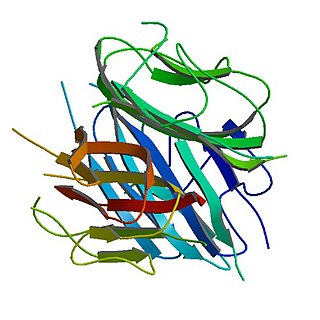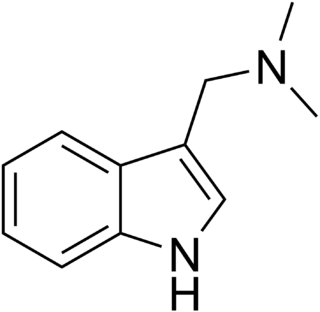Related Research Articles

Adiponectin is a protein hormone and adipokine, which is involved in regulating glucose levels and fatty acid breakdown. In humans, it is encoded by the ADIPOQ gene and is produced primarily in adipose tissue, but also in muscle and even in the brain.
The adipokines, or adipocytokines are cytokines secreted by adipose tissue. Some contribute to an obesity-related low-grade state of inflammation or to the development of metabolic syndrome, a constellation of diseases including, but not limited to, type 2 diabetes, cardiovascular disease and atherosclerosis. The first adipokine to be discovered was leptin in 1994. Since that time, hundreds of adipokines have been discovered.

Gramine is a naturally occurring indole alkaloid present in several plant species. Gramine may play a defensive role in these plants, since it is toxic to many organisms.

Parthenolide is a sesquiterpene lactone of the germacranolide class which occurs naturally in the plant feverfew, after which it is named, and in the closely related tansy. It is found in highest concentration in the flowers and fruit. Parthenolide's molecular structure depiction is often incorrect regarding the stereochemistry of the epoxide, although X-ray single crystal structures are available.
Signaling peptide receptor is a type of receptor which binds one or more signaling peptides or signaling proteins.

Matairesinol is an organic compound. It is classified as a lignan, i.e., a type of phenylpropanoid. It is present in some cereals, e.g. rye, and together with Secoisolariciresinol, has attracted much attention for its beneficial nutritional effects.

T-cadherin, also known as cadherin 13, H-cadherin (heart), and CDH13, is a unique member of the cadherin superfamily of proteins because it lacks the transmembrane and cytoplasmic domains common to all other cadherins and is instead anchored to the cell's plasma membrane by the GPI anchor.

Adiponectin receptor 1 (AdipoR1) is a protein which in humans is encoded by the ADIPOR1 gene. It is a member of the progestin and adipoQ receptor (PAQR) family, and is also known as PAQR1.

Arctigenin is a lignan found in certain plants of the Asteraceae, including the greater burdock and Saussurea heteromalla. It has shown antiviral and anticancer effects in vitro. It is the aglycone of arctiin.

Probable G-protein coupled receptor 84 is a protein that in humans is encoded by the GPR84 gene.

Membrane progesterone receptor beta (mPRβ), or progestin and adipoQ receptor 8 (PAQR8), is a protein that in humans is encoded by the PAQR8 gene.

Adiponectin receptor 2 (AdipoR2) is a protein which in humans is encoded by the ADIPOR2 gene. It is a member of the progestin and adipoQ receptor (PAQR) family, and is also known as PAQR2.

Taxifolin (5,7,3',4'-flavan-on-ol), also known as dihydroquercetin, belongs to the subclass flavanonols in the flavonoids, which in turn is a class of polyphenols.

Deoxyschizandrin is a bio-active isolate of Schisandra chinensis.
Membrane progesterone receptors (mPRs) are a group of cell surface receptors and membrane steroid receptors belonging to the progestin and adipoQ receptor (PAQR) family which bind the endogenous progestogen and neurosteroid progesterone, as well as the neurosteroid allopregnanolone. Unlike the progesterone receptor (PR), a nuclear receptor which mediates its effects via genomic mechanisms, mPRs are cell surface receptors which rapidly alter cell signaling via modulation of intracellular signaling cascades. The mPRs mediate important physiological functions in male and female reproductive tracts, liver, neuroendocrine tissues, and the immune system as well as in breast and ovarian cancer.

AdipoRon is a selective, orally active, synthetic small-molecule agonist of the adiponectin receptor 1 (AdipoR1) and adiponectin receptor 2 (AdipoR2). It activates AMPK and PPARα signaling and ameliorates insulin resistance, dyslipidemia, and glucose intolerance in db/db mice. Moreover, AdipoRon has been found to extend the lifespans of db/db mice fed a high-fat diet, as well as improve exercise endurance. The compound was discovered by Japanese researchers in 2013 via screening of a compound library, and is the first orally active, small-molecule agonist of the adiponectin receptors to be identified.

Membrane progesterone receptor epsilon (mPRɛ), or progestin and adipoQ receptor 9 (PAQR9), is a protein that in humans is encoded by the PAQR9 gene.
The progestin and adipoQ receptor (PAQR) family is a group of receptors related to but distinct from the G protein-coupled receptor family, which have the similar seven transmembrane structure, but the N-terminal is located on the inner side of the cell. It includes at least 11 receptors (PAQR1–PAQR11), including the adiponectin (adipoQ) receptors (AdipoRs), the membrane progesterone receptors (mPRs), and others.

Christos Socrates Mantzoros is a Greek American physician-scientist, practicing internist-endocrinologist, teacher and researcher. He is a professor of medicine at Harvard Medical School and an adjunct professor at Boston University School of Medicine. He currently serves as the chief of endocrinology, diabetes and metabolism at the VA Boston Healthcare System, where he created de novo a leading academic division true to its tripartite mission and as the founding director of human nutrition at Beth Israel Deaconess Medical Center (BIDMC), Harvard Medical School. Finally, he holds the editor-in-chief position of the journal Metabolism: Clinical and Experimental.
In 2010s, a series of separate allegations of scientific misconducts were raised involving several scientific papers from various Japanese universities.
References
- ↑ Tang, Y. Tom; Hu, Tianhua; Arterburn, Matthew; Boyle, Bryan; Bright, Jessica M.; Emtage, Peter C.; Funk, Walter D. (2005). "PAQR Proteins: A Novel Membrane Receptor Family Defined by an Ancient7-Transmembrane Pass Motif". Journal of Molecular Evolution. 61 (3): 372–380. Bibcode:2005JMolE..61..372T. doi:10.1007/s00239-004-0375-2. ISSN 0022-2844. PMID 16044242. S2CID 31473802.
- ↑ University of Tokyo to investigate data manipulation charges against six prominent research groups ScienceInsider, Dennis Normile, Sep 20, 2016